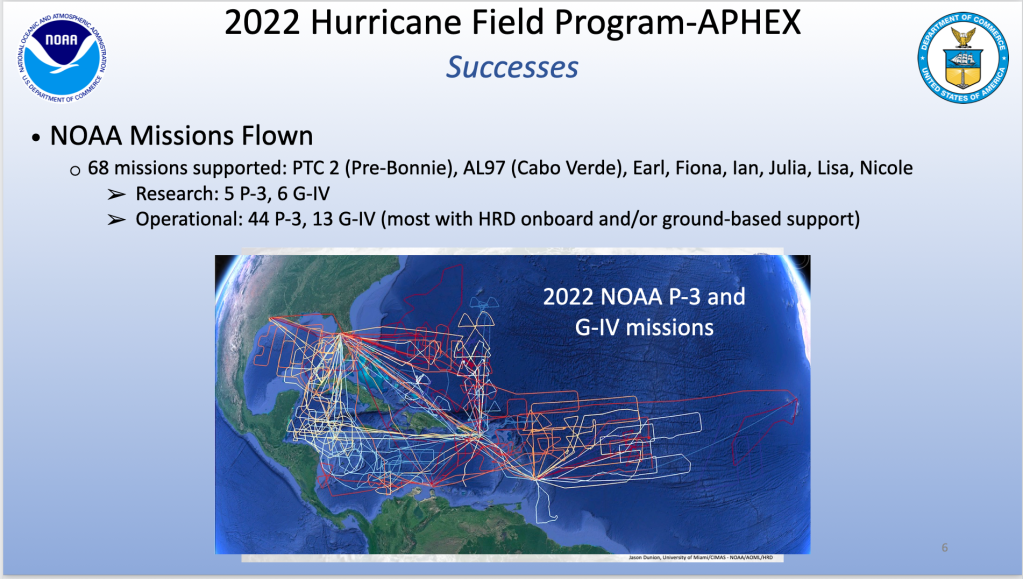Hurricane Field Program leadership held two sessions made up of a series of short science talks to wrap up the 2022 hurricane season. Talks included preliminary science results, challenges and successes in sampling and analysis strategies, modeling results, etc.
The 2022 season saw 68 missions flown by NOAA aircraft into eight different tropical system. NOAA returned to Barbados as a base of operations for the first time since 2019, and also deployed to Cabo Verde for the first time to fly systems in the Eastern Atlantic. NOAA flew into Hurricane Earl for 12 consecutive days providing one of the most comprehensive datasets of the entire lifecycle of a tropical cyclone from the time before genesis to mature hurricane status.

Other highlights included the first-ever deployment of an Altius Unscrewed System into Hurricane Ian as it approached landfall on the southwest Florida coast, providing data for 104 min and measuring wind speeds of up to 187 kt in the eyewall. The P-3s were able to perform a spiral module in stratiform precipitation above the freezing level to obtain valuable and rare information on what clouds in that region look like and coordinated dropwindsonde releases near Saildrones and gliders.
The sessions included presentations by HRD and collaborators, and the slide can be found here:
- 2022 NASA CPEX-CV Overview Ed Nowottnick
- WindBorne Global Sounding Balloon Flights During 2022 Season Todd Huchinson
- SFMR High Wind/High Rain Issues Heather Holbach
- A Review of Dropwindsonde Observations During the 2022 Hurricane Season Sim Aberson
- Using Aircraft Reconnaissance Cameras to Validate NWP Hurricane Model Forecasts Steve Albers and Zoltan Toth
- CRL Measurements and Initial Analysis Results Zhien Wang
- sUAS Mission into Hurricane Ian Joe Cione and Jun Zhang
- TCRI Update and Plans Jim Doyle
- Diagnosing Hurricane PBL Structure from SAR Imagery Ralph Foster
- HAFS-S Performance During the 2022 Hurricane Season and Comparison With P3 Observations Andy Hazelton
- Air-Sea Observations from Autonomous, Uncrewed, and Expendable Platforms: Part 1 Cheyenne Stienbarger, Jun Zhang, and Gustavo Goni
- Air-Sea Observations from Autonomous, Uncrewed, and Expendable Platforms: Part 2 Cheyenne Stienbarger, Jun Zhang, and Gustavo Goni
- Coastal Response and Impacts of Hurricane Ian L. K. Shay, B. Jaimes de la Cruz, Y. Liu, R. Weisberg, and J. Zhang
- Evolution of the Loop Current Warm Eddy that Energized Hurricane Ida Martha Schonau
- Performance of WSRA during the 2022 Hurricane Season: Validation of the WSRA Significant Wave Height Estimates Ivan PopStefanija
- Using High Altitude Dropsondes to Study Tropical Cyclones Zeljka Stone, Dave Raymond, and Stipo Sentic
- Preliminary Analysis of the Genesis of Hurricane Earl Rob Rogers
- HRD’s Vortex Alignment Module Michael Fischer
- Observations of Fiona’s Vortex Alignment Trey Alvey
For more information, contact AOML.communications@noaa.gov.